Apr 17, 2025
Apr 17, 2025
After a long gap of one and half-a-year, Shantanu, my hubby, and I suddenly planned for a short trip. It was 3 nights and 4 days tour to Khajuraho-Orchha-Jhansi. Despite being a short tour, it was undoubtedly complete enough to recharge our tired body, mind and soul. The pollution-free environment, the innocent village life and the poetic marvels of medieval India boosted the energy level of our monotonous life making the whole trip a memorable journey.
On 17th March, 2009 at 9:30 PM, we left Delhi by Sampark Kranti Express. The Train reached the newly opened Khajuraho Station at 8:30 AM on 18th March. After a quick breakfast and a little rest, we started our tour.
Day 1: 18th March.....Khajuraho
We hired an auto and headed for the stunningly exquisite temples of Khajuraho .The auto was moving through the dusty village road and the driver gave us basic information about the temples. These temples were primarily built by the rulers of Chandela Dynasty between 950 to 1050 AD. Some temples were built later on as well. These are the largest group of medieval Hindu and Jain temples which were subsequently attacked by invaders, particularly the Mughals.
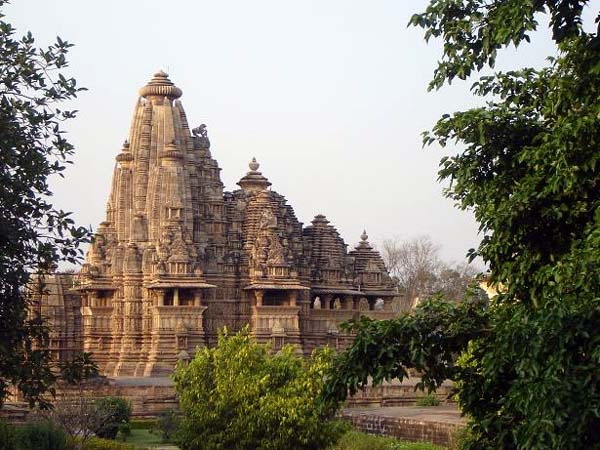
Khajuraho Temple - Western Group
These temples are divided into 3 groups - Western, Eastern and Southern which are spread over a vast expanse. In these monuments, wonderful stonework figures of Gods, Goddesses, alluring women, sexual postures, real and mythological animals, architects, dancers, musicians left us spellbound. We walked along the platform of the temples, took rest in the garden, paid heed to the deity, clicked photos but, above all, the unparalleled Indo-Aryan architecture of the temples, superb erotic scenes and the lively representation of battle, hunting, processions in the lifeless stones made us feel out-of-the-world. But, we were shocked to see that most of the statues in these monuments like, Parsvanath Temple , Adinath Temple , Shanti Nath Temple , Vamana Temple , Duladeo Temple , Chaturbhuja Temple , Lakshmana Temple , Kandariya Mahadev Temple , Devi Jagadamba Temple etc. were cruelly mutilated by the invaders. They destroyed many figures, distorted equally. But, the sheer beauty of Khajuraho till now stands proudly making these temples enlisted in the UNESCO World Heritage Site.
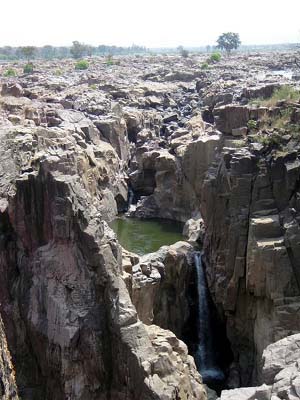 I can still remember the figure of a woman removing a thorn from her foot and another lady applying make-up on her eyes in Parsvanath Temple. In the evening we were delighted to see the Light and Sound show in the Western Group of Temples . Unfortunately, the Sound was not clearly audible at all times.
I can still remember the figure of a woman removing a thorn from her foot and another lady applying make-up on her eyes in Parsvanath Temple. In the evening we were delighted to see the Light and Sound show in the Western Group of Temples . Unfortunately, the Sound was not clearly audible at all times.
After lunch, we went to the Raneh Falls which was 18 Km. away from Khajuraho. These large and small falls on the Ken river are well-known for their fine rock formations. A 100 feet deep canyon made of pure crystalline granite and volcanic Dolomite in different colors like pink, red, yellow, black is worth a watch. Every year, in the monsoon season, the entire area gets submerged under water. Eventually, numerous seasonal falls appear which add to the beauty as well as vulnerability of that area. We stayed there for some time, listened to the music of water and then moved to the Ken Ghariyal Sanctuary through the forest area.
In Ken Ghariyal Sanctuary, though we failed to spot any Ghariyal, we got a heavenly view of the entire area atop the viewpoint. The picturesque setting of the landscape amid deep blue water was something to remember for the rest of my life.
Day 2: 19th March.....Orchha
We woke up early in the morning, checked out of the hotel and sadly found no restaurant open for our breakfast. We hardly had any time to wait since we had an 8 AM bus to Orchha. Before the bus started, we managed to sip a cup of tea with some biscuits and a small cake. It was an interesting and jerky 4 hours journey passing through the small hills and dusty villages. By 12 PM we reached Orchha and checked in the cozy little room in Hotel Sheesh Mahal. We quickly had lunch and started our tour.
Jehangir Mahal, Orchha Palace
Hotel Sheesh Mahal is situated in the wing of Jehangir Mahal of Orchha Palace . As we were already late, there was not enough time left in our hand to explore other tourist attractions. So, we decided to visit only Jehangir Mahal. Orchha palace was built in 1531 by Bundela rulers on the bank of river Betwa. It has several huge complexes. Jehangir Mahal is such a complex which was built by Maharaja Bir Singh Deo for Mughal Emperor Jehangir on his visit to Orchha in 1606.
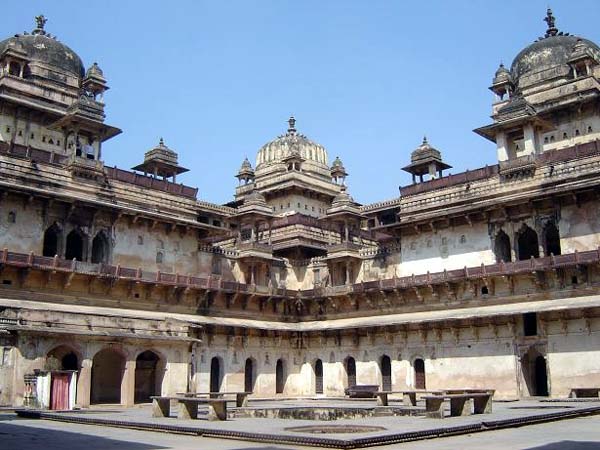
Jehangir Mahal
Typical signs of Islamic architecture is observed here. We first saw the museum on the ground floor and then climbed the stairs to reach the first and second floors. On the Second Floor, we sat on a balcony from where we could see the dancing water of river Betwa and enjoy the soothing breeze coming directly from the riverside jungle. We captured the lovely view of sunset in our camera from another part of the Mahal and came downstairs. Slowly we walked in lazy feet towards our room.
Ram Raja Temple
At 7 in the evening, we left for the famous 16th century Ram Raja Temple . It is the only temple in India where Lord Rama is worshipped as a king. Initially, it was a part of the Orccha palace. The temple has beautiful pink and gold domes. Though I am not very religious, still, I was feeling blown away by the pure spiritual wind of the temple atmosphere. I was surprised to see that the sweet vendors and other shoppers outside the temple were not disturbing anyone for selling their goods which is a common disturbing factor in almost every tourist places. I felt sad for a sick dog lying there and wanted to feed it something. I asked one of the sweet vendors to give me a few pieces of sweets. He seemed to be surprised as normally people buy bulk of sweets for puja and other purposes. He told me that he would give me some sweets without any cost. Now, it is my turn to be surprised as I have never come across any sweet vendors giving me such offer.
Day 3: 20th March.......Orchha
Cenotaphs
We visited the cenotaphs (Chattris) to Orchha's rulers. The basic architecture of these Chhatris is almost similar, only a few of them differ in uniqueness. These are scattered in a vast area on the bank of river Betwa. I found an old Shiva Lingam here. While we were chatting on a bench in the garden of this area, we noticed two vultures came to sit on the dome of one of these Chhatris. We climbed the dusty stairs and explored different complexes of the Chhatris. One similarity among these Chattris is the presence of cobwebs in all of them.
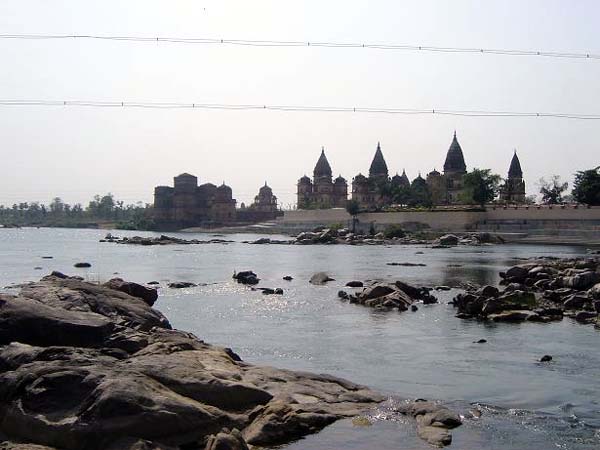
View of Cenotaphs from Betwa River
Chaturbhuja Temple
This temple resembles a palace in height and width. This was originally constructed to worship Lord Rama. We climbed the steep stairs of the temple and had an awesome view of Orchha from one of the windows. It is said that Mughal Emperor Aurangzeb once tried to destroy the temple and build a mosque in the same site. This temple is a precious example of Hindu-Muslim brotherhood as Aurangzeb's daughter saved this temple from being ruined because she was the ladylove of the then Hindu Prince of Orchha. Here we met a person who asked us for how long we would stay in Orchha. We told him that we would leave by the next day. Then he informed us that a puja would be organized within 3 days to please the GOD so that HE grants rainfall in the area. Farmers were affected badly in the last year for the drought. And those places which performed the puja last year experienced heavy downpour. So, it was their belief that rain will come positively if they please The ALMIGHTY. Needless to say that we missed the puja.
Lakshmi Narayan Temple
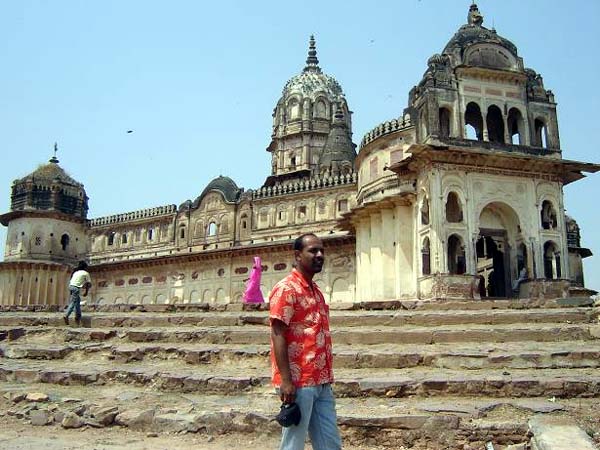
Lakshmi Narayan Temple
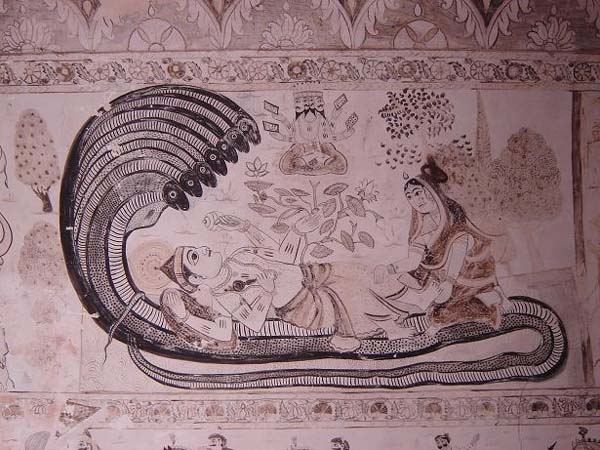
Mural in Lakshmi Narayan Temple
After Chaturbhuja temple, we headed for the Lakshmi Narayan Temple . Colorful tales of Ramayana, Mahabharata, scenes of battles, man, woman and numerous designs are artistically depicted in the beautiful wall murals. These well preserved murals make this temple a must-see. Another distinct feature of the temple is its structural similarity with the wing of an Owl at one side.
River Betwa and Nature Trail
We went to relax our tired nerves and muscles in the cool water of river Betwa where many people were swimming and washing clothes. Its fresh water energized our weak cells and gave us instant relief in scorching heat of the sun. We played with its water, sprinkled water droplets in our face and got adequate energy to roam around the nature trail in soaring temperature.
Orchha Palace
We returned to our room, had refreshment and again jumped into the lap of the palace which till date retains much of its pristine perfection. First, we explored the Raj Mahal. Although it lacks impressive stonework like Jahangir Palace , its ceilings and walls are very much alive with the vibrant murals. We saw the Camel stables behind the Jehangir Mahal. Behind the stables, located at the north of the palace there is another beautiful palace known as Rai Praveen Mahal. Rai Praveen was the beautiful paramour of Maharaja Indramani of Orchha. She was so brilliant in music, dance and poetry that her fame reached the durbar of Emperor Akbar in Agra . History has it that, he forcefully brought Rai Praveen to Agra , but, had to send her back to Orchha after being impressed by her loyalty to Indramani Singh. On her returning to Orchha in full dignity, Maharaja Indramani Singh built Rai Praveen Mahal in her honour. Lively murals of dancing girls are found in its first floor. Located near the palace is the royal 'Khana Hammam' where the royal ladies used to take bath. By then it was around late afternoon. We left the Raj Mahal palace area and moved to the other side of the small town to the palace of Dinman Hadol locally known as 'Palki Mahal'. Dinman Hardol was the son of Bir Singh Deo who organized a powerful army in Orchha making it more formidable for enemies. In order to possess Orchha, Mughal Emperor Shah Jahan made the then Orccha ruler Jujhhar Singh (brother of Dinman) believe that Dinman is having an illicit relation with Jujhaar Singh's wife. Later, Dinman commited suicide to prove his innocence. Since then Dinman is worshipped as a hero in Bundelkhand. The story was touchy indeed, but, there was little to explore in this palace.
Orchha is free of touts, peaceful and soaked in the old fragrance of a glorious past. Here, grandeur is frozen in time, but unfortunately, it lacks adequate maintenance. Many parts of the Palace, Chhatri, Temples (excluding the Ram Raja Temple ) are dusty. Surprisingly, these places are easily accessible for street dogs as well! If this is taken care of, then, Orchha has the potential to be one of the leading tourist destinations of India .
Day 4: 21st March..... Jhansi
We left Orchha by bus. It was a memorable journey because for the first time we traveled by bus where apart from the villagers goats were our co-passengers. Goats were sitting calmly with their eyes half-closed. It was very interesting experience indeed. After some time, we reached Jhansi .
Jhansi Fort:
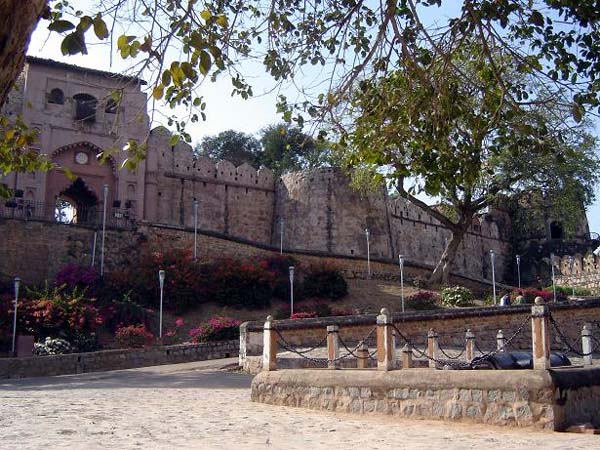
Jhansi Fort
Jhansi is well-known for its graceful queen Rani Laxmibai who sacrificed her life for Indian Independence Movement. As we were approaching the fort it seemed that the fort is glowing almost equally with the bright sun above the fort. The ageless courage, wisdom and skill of the queen were whispering in every corner of the fort which was built by Maharaja Bir Singh Deo of Orchha in 1613. From the fort of Jhansi , one can notice the hazy image of the Chaturbhuja temple and the palace of Orchha at a huge distance. Shantanu captured the place in his camera from where the Rani jumped into the hill on her horse from the fort with her son at the back. It was quite vulnerable to jump but she had to do so as the British army already captured the fort. This great warrior died in the battle against The British. The greatest compliment about her was this that She was the only man in her army.
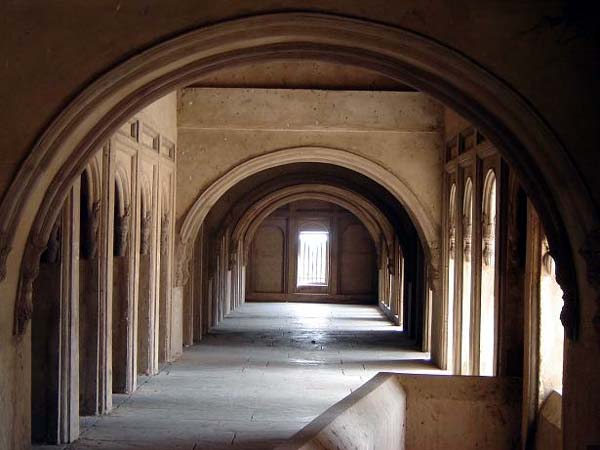
Panch Mahal
We visited the Panch Mahal which comprised of 5 Mahals (Floors). The uppermost Mahal was used by Rani laxmibai and her husband as their private room after their marriage. The other Mahals were used for servants and maid-servants, entertainment etc. Now, the superb decorations of the fort are almost lost, yet, the royal ambience is still prevalent there. We saw the court of the Rani, the Kala Kothri (here, prisoners were kept), the place where prisoners were hanged, the cemetery of the martyrs of 1858 rebellion of Jhansi . We visited the Ganesha Temple where the royal marriage of Manikarnika (name of Laxmibai before marriage) with the then King of Jhansi took place.
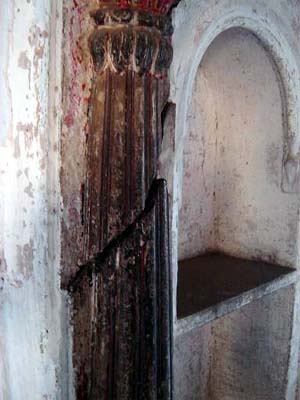 We took rest in the lush green environment of the garden of the fort and from there we went to the Rani Laxmibai Palace near the Jhansi Fort, the place where the Rani stayed after the death of her husband. Breathtakingly beautiful murals are painted on the walls and the ceilings of the building. However the most interesting aspect was abroken pillar which was the victim of Rani's sword which she hit in tremendous anger on hearing the news that the British won the battle against her army.
We took rest in the lush green environment of the garden of the fort and from there we went to the Rani Laxmibai Palace near the Jhansi Fort, the place where the Rani stayed after the death of her husband. Breathtakingly beautiful murals are painted on the walls and the ceilings of the building. However the most interesting aspect was abroken pillar which was the victim of Rani's sword which she hit in tremendous anger on hearing the news that the British won the battle against her army.
It was sad that we had our return ticket back to Delhi at 6 PM and we had to leave Jhansi . Our minds were still resonating with the legendary saga of the Rani.
History is always my favorite subject. Therefore, though I am back to my daily routine a couple of weeks back, till this moment I feel, as if, I am wandering in the silhouetted poetry of Khajuraho, floating in the limpid green water of Betwa and staring at the pleasant view of the Orchha palace or inspiring myself by the infectious courage of Maharani Laxmibai.
26-Apr-2008
More by : Dipashri Biswas

|
Ek number.. |

|
I have just gave a bird's eye view on the article with lovely photos and hope to read total tonight.expecting more new knowledge about the place. Well done Dipashri.. Commenting later on |